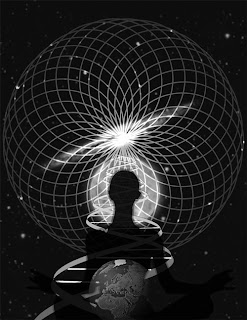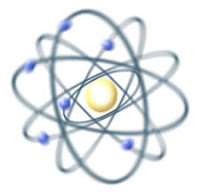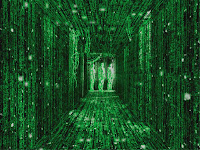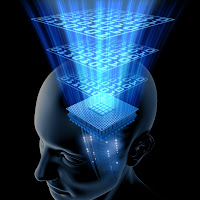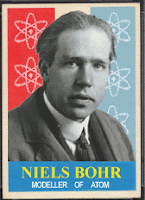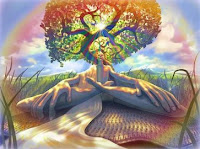For centuries the prevailing western worldview has been built upon the materialistic, mechanical model of Isaac Newton - a clockwork Universe composed of separate particles of matter interacting according to precise physical laws and existing within objective dimensions of space and time. This model has long succeeded in describing many facets of our multi-faceted reality, but increasingly since the revelations of Einstein and the paradigm-crushing implications of quantum physics, Newton’s world is quietly fading from view and being replaced by a more spiritual science.
“Up until the present, biology and physics have been handmaidens of views espoused by Isaac Newton, the father of modern physics … These, at their essence, created a world view of separateness. Newton described a material world in which individual particles of matter followed certain laws of motion through space and time – the universe as a machine …
The Newtonian world might have been law-abiding, but ultimately it was a lonely, desolate place. The world carried on, one vast gearbox, whether we were present or not … Our self-image grew even bleaker with the work of Charles Darwin.
His theory of evolution is of a life that is random, predatory, purposeless and solitary. Be the best or don’t survive. You are no more than an evolutionary accident … These paradigms – the world as a machine, man as survival machine – have led to a technological mastery of the universe, but little real knowledge of any central importance to us. On a spiritual and metaphysical level, they have led to the most desperate and brutal sense of isolation. They also have got us no closer to understanding the most fundamental mysteries of our own being: how we think, how life begins, why we get ill, how a single cell turns into a fully formed person, and even what happens to human consciousness when we die.”
-Lynne McTaggart, “The Field: The Quest for the Secret Force of the Universe,” (XXIV-XXV)
Newton’s mechanistic, mathematical model is attractive with its law-abiding, predictable structure, but it repeatedly falls short in describing a wide array of phenomena which “classical physics” is thus forced to deny or ignore. These include things such as consciousness, the observer effect, the measurement problem, Heisenberg’s uncertainty principle, non locality and quantum entanglement, particle/wave duality, bilocation, telepathy, psychokinesis, clairvoyance, precognition, out-of-body experiences, near-death experiences, ghosts, shamanic/spiritual healing, acupuncture, prayer, the placebo effect, psychoneuroimmunology and many more anomalies, all of which are at odds with classical physics and will be examined in the coming chapters.
“The world view which was changed by the discoveries of modern physics had been based on Newton’s mechanical model of the universe. This model constituted the solid framework of classical physics. It was indeed a most formidable foundation supporting, like a mighty rock, all of science and providing a firm basis for natural philosophy for almost three centuries. The stage of the Newtonian universe, on which all physical phenomena took place, was the three-dimensional space of classical Euclidean geometry. It was an absolute space, always at rest and unchangeable. In Newton’s own words, ‘Absolute space, in its own nature, without regard to anything external, remains always similar and immovable.’ All changes in the physical world were described in terms of a separate dimension, called time, which again was absolute, having no connection with the material world and flowing smoothly from the past through the present to the future. ‘Absolute, true, and mathematical time,’ said Newton, ‘of itself and by its own nature, flows uniformly, without regard to anything external.”
-Fritjof Capra, “The Tao of Physics” (55)
The first steps away from Newtonian physics came with Einstein’s theory (and subsequent experimental proofs) of relativity showing Newton to be incorrect in his view of absolute space and absolute time. Instead, both space and time have proven to be relativistic, interrelated concepts which are now more appropriately referred to as “space-time.” As written by physicist Mendel Sachs, “The real revolution that came with Einstein’s theory . . . was the abandonment of the idea that the space-time coordinate system has objective significance as a separate physical entity. Instead of this idea, relativity theory implies that the space and time coordinates are only the elements of a language that is used by an observer to describe his environment.” Einstein showed that space and time are not absolute structures with independent a priori existence as classical physics espouses. In fact, space and time are relativistic and subjective, a notion which metaphysically places them subordinate to the mind/consciousness perceiving them! The mystical implications of this discovery are vast and will be covered in detail later, but first let’s examine whether or not we even live in a “material” universe at all. What has modern physics discovered about atoms, the so-called building blocks of matter?
“For two thousand years it was believed that atoms were tiny solid balls – a model clearly drawn from everyday experience. Then, as physicists discovered that atoms were composed of more elementary, sub-atomic particles (electrons, protons, neutrons and suchlike) the model shifted to one of a central nucleus surrounded by orbiting electrons – again a model based on experience. An atom may be small, a mere billionth of an inch across, but these sub-atomic particles are a hundred thousand times smaller still. Imagine the nucleus of an atom magnified to the size of a grain of rice. The whole atom would then be the size of a football stadium, and the electrons would be other grains of rice flying round the stands. As the early twentieth-century British physicist Sir Arthur Eddington put it, ‘matter is mostly ghostly empty space’ – 99.9999999% empty space, to be a little more precise.”
-Peter Russell, “From Science to God”
How can something which is 99.9999999% empty space be considered the building block of matter? And what is the fundamental “stuff” of the universe if not matter? If there is almost no substance to our seemingly solid, tangible world, what causes the illusion? German physicist Hans-Peter Dürr keenly noted, “Matter is not made of matter.” So what is it made of?
“For a start, what we perceive to be 'physical' and 'solid' is anything but. Science says that what we see as 'form' - people, buildings, landscape etc. - are made of atoms. Okay, but the trouble with the 'solid world' theory is that atoms are not solid. More than that, they are basically empty. How can something that is not solid create a solid environment? It can't. Atoms consist of electrons orbiting a nucleus (protons and neutrons), but it is the proportions that tell the story. Atoms are more than 99% empty space to our human reality, yet they are described as the fundamental building-blocks of matter - yes, 'solid' matter.”
–David Icke, “The David Icke Guide to the Global Conspiracy” (34)
“Examine each part of the cabin. The walls are made of wood. What makes wood what it is? A configuration of wood cells exists as a log, and each of these cells cannot exist without a configuration of molecules. Likewise, each molecule is composed of atoms. Each atom contains electrons, protons, and neutrons. Each atomic particle is composed of quarks, etc., etc., etc. Everything can be broken down into parts. Even if somehow a ‘thing’ was found that could not be broken down, it would still have parts because if it did not, it could not be used to make more complex things. Anything that has spatial extent requires that it has a front, a back, a shape – different parts. At the level of atoms, the distance from one atom to another in relationship to the diameter of the nucleus of the atom is ‘astronomical.’ There is more emptiness in the atoms composing the wall of a cabin than there is matter! And this goes for all matter. All matter is mostly emptiness … What prevents your hand, for example, from passing through a wall is not that there is some ‘thing’ or ‘things’ (atoms) in the way, but more so because there is an atomic energy field that prevents the atoms from one’s hand to pass by the atoms of the wall.”
–Aaron G. L. Adoni, “The Gnosis of Kali Yuga” (137)
When touching a wall with your hand, both the wall and your hand are composed of 99.9999999% empty space, so your sensation of touching some “thing” comes not from physically colliding hand-atoms with wall-atoms, but rather from an energetic charge between them. That energetic charge is then electro-chemically interpreted by your brain into your felt experience of “wall.”
“How can something that is not solid be the building blocks that construct this 'solid' wall I am looking at now? It can't - our brains do it. With the emergence of quantum physics, science has had to concede that atoms are not solid … The atoms that comprise 'physical' matter are overwhelmingly 'empty' and even illustrations of this are misleading because there is not enough room in a book or science paper to accurately depict the proportions of particles to 'empty space'. As one writer put it: 'If an atom was the size of a cathedral, the nucleus would be about the size of a ten cent piece.’ The rest is ‘empty’ to the perception of the five senses because it consists of energy vibrating on wavelengths higher than the 'physical', and even the particles are found to be empty as you go deeper into the subatomic realm. If you magnify anything powerfully enough and go deeper than the atom, you will find that nothing has solidity - No, not even buildings, cars, mountains or the bones in your body. It's Illusion! If you find this hard to accept, think of your dreams. You dream in three-dimensional images and yet no one claims they are solid do they?”
–David Icke, “Infinite Love is the only Truth, Everything Else is Illusion” (40)
“Quantum theory thus reveals an essential interconnectedness of the universe. It shows that we cannot decompose the world into independently existing smallest units. As we penetrate into matter, we find that it is made of particles, but these are not the ‘basic building blocks’ in the sense of Democritus and Newton. They are merely idealizations which are useful from a practical point of view, but have no fundamental significance.”
-Fritjof Capra, “The Tao of Physics” (137)
Nobel Prize winning physicist Niels Bohr was the inventor of the Bohr Atom Model seen in every high-school physics/chemistry textbook depicting the atom as a mini solar system with a central nucleus orbited by bands of electrons. He created this model of the atom with which we are all so familiar, yet he himself knew the model was incorrect at a fundamental level. He wrote that, “Isolated material particles are abstractions, their properties being definable and observable only through their interaction with other systems.” In other words, no atom or sub-atomic particle has an isolated, separate existence. No material particle has independent properties or location as distinct from any other. At the atomic and subatomic levels, no “thing” is separate from every “thing” else – there is just one field of pulsating energy that composes the entire physical universe. It has been called The Ether, The Field, The Quantum Field, The Zero-Point Field, and many other names, all referring to this essential, energetic oneness. So, not only was Newton’s classical physics incorrect about absolute space and time, it was incorrect about the universe being composed of separate particles of matter.
“This world of separate should have been laid waste once and for all by the discovery of quantum physics in the early part of the twentieth century. As the pioneers of quantum physics peered into the very heart of matter, they were astounded by what they saw. The tiniest bits of matter aren’t even matter, as we know it, not even a set something, but sometimes one thing, sometimes something quite different. And even stranger, they are often many possible things all at the same time. But most significantly, these subatomic particles have no meaning in isolation, but only in relationship with everything else. At its most elemental, matter cannot be chopped up into self-contained little units, but is completely indivisible. You can only understand the universe as a dynamic web of interconnection. Things once in contact remain always in contact through all space and all time. Indeed, time and space themselves appear to be arbitrary constructs, no longer applicable at this level of the world. Time and space as we know them do not, in fact, exist. All that appears, as far as the eye can see, is one long landscape of the here and now.”
-Lynne McTaggart, “The Field: The Quest for the Secret Force of the Universe,” (XXV)
Everyone knows Einstein’s famous formula E=MC2meaning Energy = Mass x Light Speed squared. What we’re seldom taught, however, are the implications of this equation. E=MC2 shows that matter and energy are really just two different forms of the same thing. Einstein’s formula and quantum physics have both verified that all matter is really just energy vibrating at a low frequency. This means that energy, the one undifferentiated field of quantum zero-point energy, is the primary reality; So-called “empty” space, “solid” matter, and “separate” forms, are just subjective interpretations of the one underlying energy. As Albert Einstein himself said, “We may therefore regard matter as being constituted by the regions of space in which the field is extremely intense … There is no place in this new kind of physics both for the field and matter, for the field is the only reality.”
“The discovery that mass is nothing but a form of energy has forced us to modify our concept of a particle in an essential way. In modern physics, mass is no longer associated with a material substance, and hence particles are not seen as consisting of any basic ‘stuff’, but as bundles of energy.”
-Fritjof Capra, “The Tao of Physics” (202)
Experiments in quantum physics have shown that atoms and all subatomic particles are more like verbs than nouns. They are more like energy bundles or patterns of quantum potential than they are like solid billiard balls or mini solar systems. The underlying primary reality is the energy field, and “energy” itself is more a verb, an action, a potential, than a noun – it’s not some set “thing.” When we peer deeply into the subatomic levels of matter, we see only this energy, this constantly flowing, interacting field. To make sense of it we create nouns/models like atoms, electrons, quarks, but the most appropriate “model” would be a verb, like “universal energizing.”
“These dynamic patterns, or ‘energy bundles’, form the stable nuclear, atomic and molecular structures which build up matter and give it its macroscopic solid aspect, thus making us believe that it is made of some material substance. At the macroscopic level, this notion of substance is a useful approximation, but at the atomic level it no longer makes sense. Atoms consist of particles and these particles are not made of any material stuff. When we observe them, we never see any substance; what we observe are dynamic patterns continually changing into one another - a continuous dance of energy.”
-Fritjof Capra, “The Tao of Physics” (203)
 “Prior to Einstein’s theory of relativity and quantum physics we held a firm conviction that the universe was composed of solid matter. We believed that the basic building blocks of this material universe were atoms, which we perceived as compact and indestructible. The atoms existed in three-dimensional space and their movements followed certain fixed laws. Accordingly, matter evolved in an orderly way, moving from the past, through the present, into the future. Within this secure, deterministic viewpoint we saw the universe as a gigantic machine … Within this image of the universe developed by Newtonian science, life, consciousness, human beings, and creative intelligence were seen as accidental by-products that evolved from a dazzling array of matter. As complex and fascinating as we might be, we humans were nevertheless seen as being essentially material objects – little more than highly developed animals or biological thinking machines. Our boundaries were defined by the surface of our skin, and consciousness was seen as nothing more than the product of that thinking organ known as the brain.”
“Prior to Einstein’s theory of relativity and quantum physics we held a firm conviction that the universe was composed of solid matter. We believed that the basic building blocks of this material universe were atoms, which we perceived as compact and indestructible. The atoms existed in three-dimensional space and their movements followed certain fixed laws. Accordingly, matter evolved in an orderly way, moving from the past, through the present, into the future. Within this secure, deterministic viewpoint we saw the universe as a gigantic machine … Within this image of the universe developed by Newtonian science, life, consciousness, human beings, and creative intelligence were seen as accidental by-products that evolved from a dazzling array of matter. As complex and fascinating as we might be, we humans were nevertheless seen as being essentially material objects – little more than highly developed animals or biological thinking machines. Our boundaries were defined by the surface of our skin, and consciousness was seen as nothing more than the product of that thinking organ known as the brain.” -Stanislav Grof, “The Holotropic Mind,” Harper, (4)
On a metaphysical level, the Newtonian worldview has instilled a common belief that all life, consciousness, and the diversity of nature are merely serendipitous accidents evolving out of complex interactions between particles of physical matter. The idea that life, consciousness, and the complexity of nature arose by accident, for holistic thinkers, seems like a ludicrous improbability. But for so-called logical, scientific thinkers, this worldview has long-standing merit. Many are happy to accept that space, time, and matter all spontaneously came from nowhere for no reason; that a sneezing singularity expanded and evolved through trial and error and survival of the fittest over billions of years. At some point, somehow, life and consciousness arose from non-living, unconscious matter, then continued gaining complexity through time until humanity, the pinnacle of billions of years of mechanical evolution, emerged with all these perceptions, sensations, emotions, and internal experiences just by accident.
“Traditional science holds the belief that organic matter and life grew from the chemical ooze of the primeval ocean solely through the random interactions of atoms and molecules. Similarly, it is argued that matter was organized into living cells, and cells into complex multicellular organisms with central nervous systems, solely by accident and ‘natural selection.’ And somehow, along with these explanations, the assumption that consciousness is a by-product of material processes occurring in the brain has become one of the most important metaphysical tenets of the Western worldview. As modern science discovered the profound interactions between creative intelligence and all levels of reality, this simplistic image of the universe becomes increasingly untenable. The probability that human consciousness and our infinitely complex universe could have come into existence through the random interactions of inert matter has aptly been compared to that of a tornado blowing through a junkyard and accidentally assembling a 747 jumbo jet.”
-Stanislav Grof, “The Holotropic Mind” (5)
“Many processes certainly appear to be explainable in approximately mechanistic, reductionistic terms. But as physicists have delved progressively deeper into the nature of reality, they find that it cannot be understood in mechanistic terms. Mechanism assumes that there are separate objects that interact in determined, causal ways. But that’s not the reality we live in. Quantum reality is holistic, and as such any attempt to study its individual pieces will give an incomplete picture. It’s like studying atoms inside an acorn in an attempt to understand the emergence of leaves on an oak tree – a futile exercise.”
-Dean Radin, “Entangled Minds” (222)



